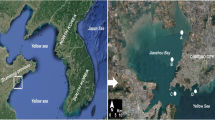Abstract
Biological trait analysis (BTA) of protozoan communities has been used a useful bioindicator of environmental quality status in marine ecosystems. To determine the optimal water depths for bioassessment using multiple functional traits of periphytic protozoa, community functioning was studied at different water depths in the Yellow Sea, northern China. The community-weighted means (CWM) of bacterivores with small sizes showed an increasing trend from surface layers to the deeper ones, while those of algivores with medium and large sizes revealed an opposite trend, i.e., a decreasing trend from surface layers to deeper ones. However, with those of predators were distributed at depths of 2 to 3.5 m. There was a significant difference in the functional patterns, except for those at depths of 2 to 3.5 m (P > 0.05). All diversity indices except FDiv generally peaked and leveled off at either 2 or 3.5 m although they decreased with depth. The results suggest that sampling at depths of 2 and 3.5 m may be an optimal strategy for assessing water quality using the functional pattern of protozoa in coastal ecosystems.
Similar content being viewed by others
References
Abdullah Al M, Gao Y, Xu G, Wang Z, Warren A, Xu H (2018) Trophic-functional patterns of biofilm-dwelling ciliates at different water depths in coastal waters of the Yellow Sea, northern China. Eur J Protistol 63:34–43
Abdullah Al M, Gao Y, Xu G, Wang Z, Xu H, Warren A (2017) Variations in the community structure of biofilm-dwelling protozoa at different depths in coastal waters of the Yellow Sea, northern China. J Mar Biol Assoc UK. doi:10.1017/S0025315417001680 (in press)
Anderson MJ, Gorley RN, Clarke KR (2008) PERMANOVA+ for PRIMER guide to software and statistical methods. PRIMER-E Ltd, Plymouth, 214 p
Bremner J, Rogers SI, Frid CLJ (2006) Matching biological traits to environmental conditions in marine benthic ecosystems. J Marine Syst 60:302–316
Clarke KR, Gorley RN (2015) PRIMER v7: user manual/tutorial. PRIMER-E Ltd, Plymouth, 296 p
Dimitriadis C, Evagelopoulos A, Koutsoubas D (2012) Functional diversity and redundancy of soft bottom communities in brackish waters areas: local vs regional effects. J Exp Mar Biol Ecol 426:53–59
Gusmao JB, Brauko KM, Eriksson BK, Lana PC (2016) Functional diversity of macrobenthic assemblages decreased in response to sewage discharges. Ecol Indic 66:65–75
Hewitt JE, Thrush SF, Dayton PK (2008) Habitat variation, species diversity and ecological functioning in a marine system. J Exp Mar Biol Ecol 366:116–122
Laliberte E, Legendre P (2010) A distance-based framework for measuring functional diversity from multiple traits. Ecology 91:299–305
Laliberte E, Legendre P, Shipley B (2014) FD: measuring functional diversity from multiple traits, and other tools for functional ecology. R package version 3.0
Mason NWH, Mouillot D, Lee WG, Wilson JB (2005) Functional richness, functional evenness and functional divergence: the primary components of functional diversity. Oikos 111:112–118
Mouchet M, Villeger S, Mason N, Mouillot D (2010) Functional diversity measures: an overview of their redundancy and their ability to discriminate community assembly rules. Funct Ecol 24:867–876
Paganelli D, Marchini A, Occhipinti-Ambrogi A (2012) Functional structure of marine benthic assemblages using biological traits analysis (BTA): a study along the Emilia-Romagna coastline (Italy, North-West Adriatic Sea). Estuar Coast Shelf S 96:245–256
Song W, Warren A, Hu X (2009) Free-living ciliates in the Bohai and Yellow Seas, China. Science Press, Beijing, 518 p
Villeger S, Mason NWH, Mouillot D (2008) New multidimensional functional diversity indices for a multifaceted framework in functional ecology. Ecology 89:2290–2301
Villeger S, Miranda JR, Hernández DF, Mouillot D (2010) Contrasting changes in taxonomic vs. functional diversity of tropical fish communities after habitat degradation. Ecol Appl 20:1512–1522
Wang Z, Xu G, Zhao Lu, Gao Y, Abdullah Al M, Xu H (2017) A new method for evaluating defense of microalgae against protozoan grazing. Ecol Indic 77:261–266
Xu G, Xu Y, Xu H (2016) Insights into discriminating water quality status using new biodiversity measures based on a trait hierarchy of body-size units. Ecol Indic 60:980–986
Xu G, Zhang W, Xu H (2015) Can dispersions be used for discriminating water quality status in coastal ecosystems? A case study based on biofilm-dwelling microbial eukaryotes. Ecol Indic 57:208–214
Xu G, Zhong X, Abdullah AM, Warren A, Xu H (2018a) Identifying bioindicators across trait-taxon space for assessing water quality in marine environments. Mar Pollut Bull 131:565–571
Xu H, Zhang W, Jiang Y, Yang EJ (2014) Use of biofilm-dwelling ciliate communities to determine environmental quality status of coastal water. Sci Total Environ 470–471:511–518
Xu Y, Fan X, Warren A, Zhang L, Xu H (2018b) Functional diversity of benthic ciliate communities in response to environmental gradients in a wetland of Yangtze Estuary, China. Mar Pollut Bull 127:726–732
Zhang W, Xu H, Jiang Y, Zhu M, Al-Reshaid KAS (2012) Colonization dynamics in trophic-functional structure of periphytic protist communities in coastal waters. Mar Biol 159:735–748
Zhong X, Xu G, Xu H (2017a) An approach to analysis of colonization dynamics in community functioning of protozoa for bioassessment of marine pollution. Ecol Indic 78:526–530
Zhong X, Xu G, Xu H (2017b) Use of multiple functional traits of protozoa for bioassessment of marine pollution. Mar Pollut Bull 119:33–38
Author information
Authors and Affiliations
Corresponding author
Rights and permissions
About this article
Cite this article
Guo, C., Bai, X., Abdullah Al, M. et al. Determining Water Depths for Monitoring Coastal Water Quality Using Multiple Functional Traits of Periphytic Protozoa in Marine Ecosystems. Ocean Sci. J. 54, 87–95 (2019). https://doi.org/10.1007/s12601-018-0058-3
Received:
Revised:
Accepted:
Published:
Issue Date:
DOI: https://doi.org/10.1007/s12601-018-0058-3




